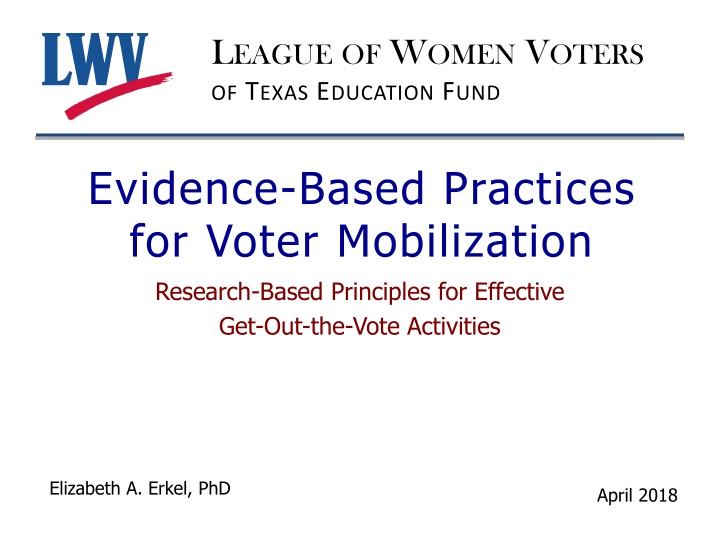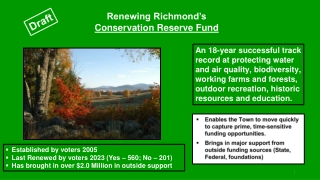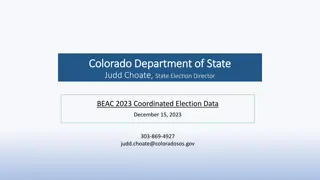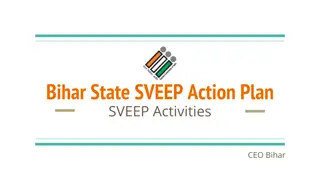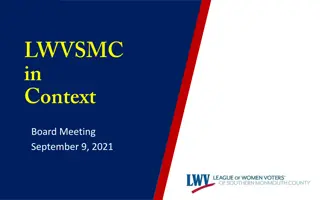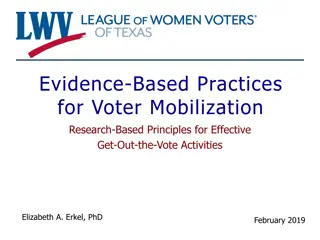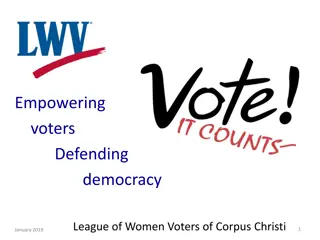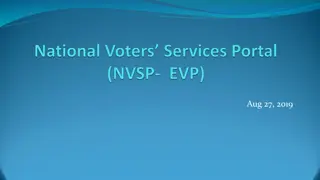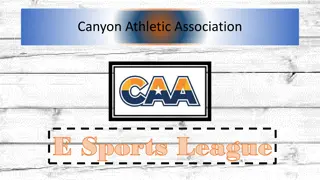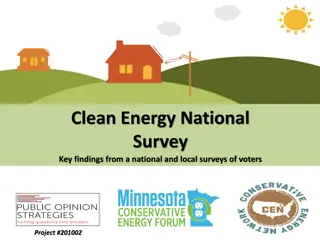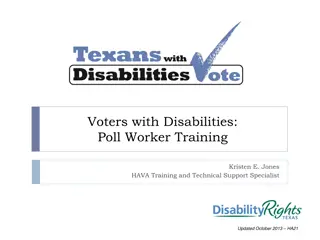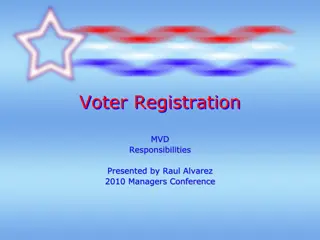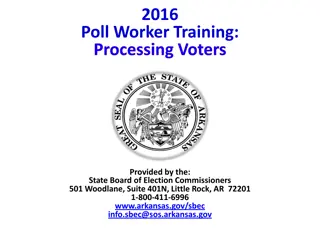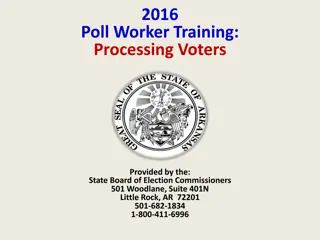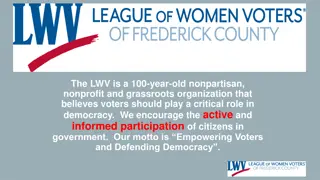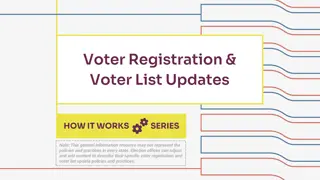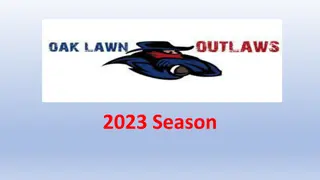Evidence-Based Practices for Voter Mobilization by League of Women Voters of Texas Education Fund
This guide provides research-based principles and effective strategies for voter mobilization, aiming to enhance voter turnout through evidence-based practices. It covers dos and don'ts of voter mobilization, emphasizing the importance of connecting with voters on a personal level and focusing on the act of voting rather than specific issues or candidates. Tailoring messages and utilizing gentle social pressure are highlighted as effective tactics for mobilizing voters successfully.
Download Presentation

Please find below an Image/Link to download the presentation.
The content on the website is provided AS IS for your information and personal use only. It may not be sold, licensed, or shared on other websites without obtaining consent from the author.If you encounter any issues during the download, it is possible that the publisher has removed the file from their server.
You are allowed to download the files provided on this website for personal or commercial use, subject to the condition that they are used lawfully. All files are the property of their respective owners.
The content on the website is provided AS IS for your information and personal use only. It may not be sold, licensed, or shared on other websites without obtaining consent from the author.
E N D
Presentation Transcript
LEAGUE OF WOMEN VOTERS OF TEXAS EDUCATION FUND Evidence-Based Practices for Voter Mobilization Research-Based Principles for Effective Get-Out-the-Vote Activities Elizabeth A. Erkel, PhD April 2018
Table of Contents Preface 1. The dos & don ts of voter mobilization 2. Mobilizing voters is not 3. To mobilize voters 4. Voter mobilization resources 5. References 3 5 18 19 20 21 April 2018 2
Preface Welcome! This tutorial will help you understand the principles behind effective GOTV campaigns. For what works, see Tactics That Work for Voter Mobilization For talking effectively with voters, see: What to Say: Effective GOTV Conversations Each election, each potential voter, and each get-out-the- vote (GOTV) effort is unique. Thus it is critical to tailor your message. Regardless of the type of GOTV activity and your audience, your efforts will be more effective if guided by evidence-based practices. GOTV action involves vision, strategy, and tactics as depicted on the next page. https://my.lwv.org/texas/best-practices-gotv April 2018 3
GOTV Action Program * 2012 to 2020 5% from *Evidence-based practices April 2018 Adopted by LWVTX Convention 2016 4
1. THEDOS & DONTSOF VOTERMOBILIZATION Focus on voting Connect with the voter Use gentle social pressure Help make a plan for voting Advocate for issues or candidates Discuss that people aren t voting Rely on impersonal emails, display ads, or robo-calls April 2018 5
Focus on voting The goal is to transform nonvoters into voters not to change minds about an issue or a candidate. Advocating for issues may diminish your influence on voter turnout. The League does not support or oppose candidates or political parties x Advocacy & Communications Solutions, 2015, p.7 Green & Gerber, 2015, p. 7 April 2018 6
Connect with the voter Emphasize that you are local, e.g.: A neighbor From a local organization Acknowledge a commonality between you and your contact. Be enthusiastic. Ask questions. Share a voting story of your own. Messengers with something in common with the community are more effective than outsiders. April 2018 Angone, 2015; British Council, n.d.; Nickerson & Rogers, 2010; Yale University, n.d. 7
Connect with the voter Timing Use different periods of the election season to greatest effect. Focus messaging on a specific topic within the 2 weeks before its deadline: Voter registration Vote-by-mail applications Early voting Election Day April 2018 8 Green & Gerber, 2015, p.33; Nonprofit Vote, n.d.
Connect with the voter How often? Aim to make one contact with each targeted voter through multiple attempts if needed. One successful contact with lots of voters is more effective than multiple contacts with fewer voters. Multiple contacts are most effective with occasional voters but require substantial resources. April 2018 Cendejas & Guerra, 2014 9
Connect with the voter Targeting the electorate Target those who need a little encouragement to vote, especially: First-time voters Young people Ethnic/racial minorities People with a low income Arceneaux & Nickerson, 2009; Gerber & Rogers, 2009, pp. 6 & 13 Green & Gerber, 2015, pp. 47, 82, & 94 April 2018 10
Use gentle social pressure Let potential voters know that someone is paying attention to whether or not they participate in the election. Tell them that others like themselves have committed to being voters. Remind them of their past voting history (it s public record). Promise to follow-up with them after the election (and do so!). We are social creatures and want to fit in. Gerber, Green, & Larimer, 2008; Green & Gerber, 2015, p. 144-151 April 2018 11
Help make a plan for voting Getting potential voters to think through the steps they need to take makes them more likely to act on their intent to vote. Planning to be a voter What to Take to the Polls Voter registration card One of the acceptable voter IDs List of who/what to vote for Nonpartisan Resources Voter information websites VOTE411.org, VoteTexas.gov County elections website my.LWV.org/Texas local League website League voters guides Assess difficulty How When Where Special plans Deadlines Registration Vote-by-mail Voting dates Polling places Find voter ID information at my.LWV.org/Texas/IDs April 2018 Nickerson & Rogers, 2010 12
Help make a plan for voting Assist voter in getting ready to vote. LWV-TX social media business card available at my.lwv.org/texas/get-out-vote-0 Bookmarks individualized for each local League available at my.LWV.org/Texas/vote-it-counts April 2018 13
Hearing that others are voting encourages voting among infrequent and occasional voters. Your [classmates, neighbors, etc.] have been telling me that they are definitely voting in this election. Do you plan on being a voter? We're expecting a high turnout this election. More and more people are voting. Telling people that others are not voting can suppress voter turnout. Don t talk about how people aren t voting low voter turnout April 2018 Schwartz & Rogers, 2010 14
The single most important element of voter mobilization is urging the person to be a voter. How important is it for you to be a voter in this upcoming election? Can I count on you being a voter in this election? Persuasion messages have no effect on whether or not a person will vote! An issue-focused message is unlikely to increase voter turnout. The League does not endorse or oppose any candidate or political party. Don t advocate voting for Issues or Candidates April 2018 Green & Gerber, 2015, pp. 34 & 156-157 15
Impersonal mass communication is ineffective in increasing voter turnout. But friend-to-friend personalized communication that encourages voting through a series of chatty posts is about as effective as face-to-face canvassing. Rely on impersonal Robocalls Mass emails Display ads April 2018 Brooks, 2017; Green & Gerber, 47, 82, 94, & 126-127 16
Issues Candidates Help make a voting plan Don t advocate for issues or candidates Use gentle social pressure Don t rely on impersonal communication April 2018 17
2. MOBILIZING VOTERSISNOT merely a matter of reminding them that Election Day is near. just a matter of putting election-related information in front of them. telling people why they should vote for a particular candidate or cause . April 2018 Green & Gerber, 2015, p. 156 18
3. TOMOBILIZEVOTERS Make them feel wanted at the polls. In-person invitations convey the most warmth and work best. Next best are personalized telephone calls or personalized chatty posts on social media. Build on voters preexisting level of motivation to vote. Let them know that their vote is a matter of public record. April 2018 Green & Gerber, 2015, pp. 156-157 19
4. VOTERMOBILIZATION RESOURCES Tactics That Work What to Say Engaging Target Populations Asian and Pacific Islanders Latinos Millennials Youth https://my.lwv.org/texas/best-practices-gotv April 2018 20
